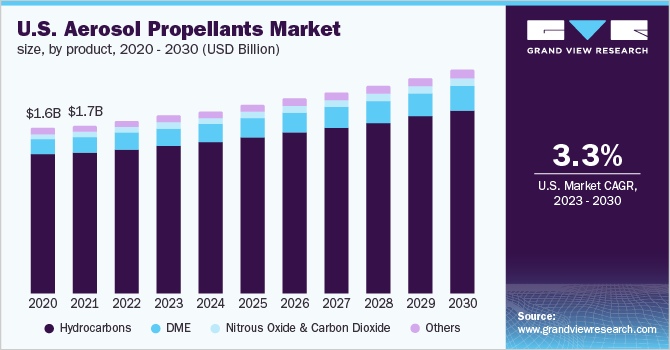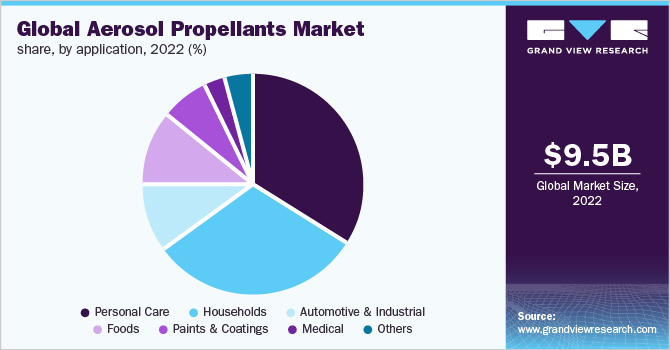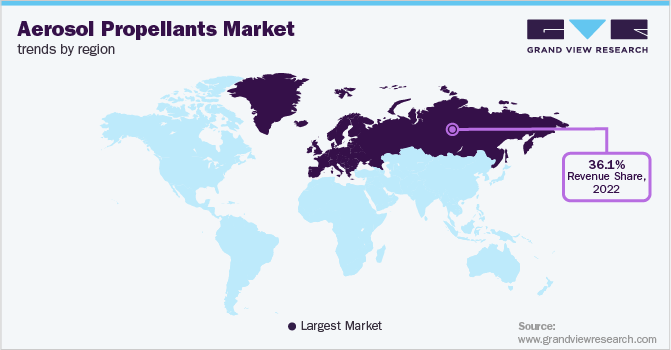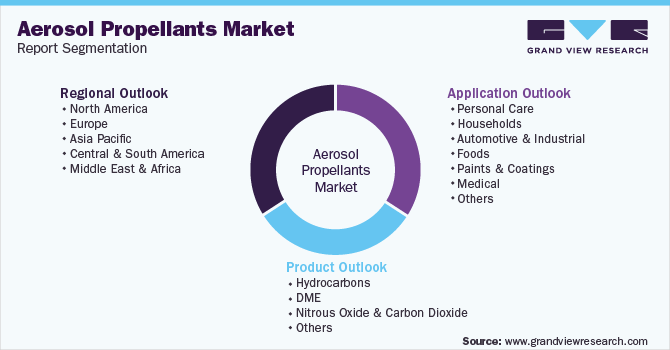- Home
- »
- Advanced Interior Materials
- »
-
Aerosol Propellants Market Size, Share & Trends Report, 2030GVR Report cover
![Aerosol Propellants Market Size, Share & Trends Report]()
Aerosol Propellants Market Size, Share & Trends Analysis Report By Product (Hydrocarbons, DME, Nitrous Oxide & Carbon Dioxide), By Application, By Region And Segment Forecasts, 2023 - 2030
- Report ID: 978-1-68038-338-6
- Number of Report Pages: 90
- Format: PDF, Horizon Databook
- Historical Range: 2018 - 2021
- Forecast Period: 2023 - 2030
- Industry: Advanced Materials
Report Overview
The global aerosol propellants market size was valued at USD 9.47 billion in 2022 and is expected to expand at a compound annual growth rate (CAGR) of 6.4% from 2023 to 2030. The growing application of aerosol propellants in personal care products, and cosmetics, is expected to drive product demand. Furthermore, new product launches in shaving foams, shampoos, deodorants, and antiperspirants are expected to create immense growth potential during the forecast period.

Growing demand for aerosols in various food products including whipped creams, mayonnaise, chocolate, and others is expected to propel industry growth throughout the forecast period. The high market potential for packaged foods in emerging economies including India, China, the UAE, Egypt, and Iran is expected to fuel product demand in the food & beverage industry during the forecast period. In addition, increasing demand for aerosol propellants in household products, including air fresheners, insect repellents, and disinfectants is projected to trigger market growth.
Aerosol propellants are commercially available solutions for easy and direct application. Different types of aerosol propellants, namely, hydrocarbons, dim ethyl ether (DME), CFC, and compressed gas including nitrogen and carbon dioxide, are commercially available. These are mainly sourced from methanol, coal, natural gas, and carbon. The aforementioned raw materials are supplied by various companies present in the market including Aestra Co. Ltd, DME Aerosol, Methanex Corporation, Arttu Group, Gazprom, BP, AMPCO, and Qatar Fuel Additives Company Limited.
The growing aged population has propelled the use of aerosols in anti-aging cosmetic products which has further contributed to the increasing demand for propellants. However, various environmental and health risks associated with the use of propellants in aerosol products are expected to restrain market growth throughout the forecast period. Technological advancements and innovations to develop eco-friendly, low-cost, and low-VOC products are further expected to open new growth opportunities for the market in the near future.
In developed regions such as North America and Europe, prominent companies are launching new products with low energy and fewer amounts of raw materials, thus, driving the market growth during the forecast period. Moreover, urbanization along with infrastructure development in the Middle East is expected to augment the market throughout the forecast period. Technological advancements such as stahl monoblock aerosol cans and airless dispensers are expected to fuel market growth. Furthermore, increasing demand for mouthwash, breath freshener, and teeth whitening treatments is expected to boost aerosol demand.
Product Insights
The hydrocarbons segment dominated the market with the highest revenue share of 80.7% in 2022. Its high share is attributable to the increasing use of the product in pharmaceutical aerosols on account of their low toxicity, low cost, and non-reactivity, making them environmentally friendly. In addition, they do not contain halogen, which makes them excellent propellants, or water-based aerosols, thus, positively impacting their demand during the forecast period.
The dimethyl ether (DME) and methyl ethyl ether segment is expected to register significant growth over the forecast period owing to its advantageous properties of high solvency, chemical stability, low toxicity, and water miscibility, making it useful in several products such as paints and hair sprays. Furthermore, the low prices of DME and its environmental friendliness are anticipated to boost its demand in the coming years.
DME is widely used in personal care products such as perfumes & deodorants and home care products such as air fresheners, insect repellants, and fabric care. The market for DME aerosol propellants is likely to grow at a faster pace in European countries on account of the high living standards of citizens, especially in countries such as the U.K., France, and Germany.
Nitrous oxide is obtained by heating ammonium nitrate and is stored in gas balloons. It is compressed, dried, and refrigerated, following which it is transferred to high-pressure storage vessels. It is used as an aerosol propellant owing to its easy availability, low- cost, and properties such as colorless and non-flammable gaseous nature. The increasing demand for carbon dioxide and nitrous oxide aerosol propellants in the distribution of dental creams, food products, ointments, and hair product is likely to augment the market growth during the forecast period.
Application Insights
The personal care segment dominated the market with the highest revenue share of 34.2% in 2022. Its high share is attributable to different factors such as economic growth, growing middle-class population, and increasing per capita income. Deodorants and antiperspirants are considered daily-use products. Factors such as healthy ingredients, eye-catching packaging designs, and innovation in packaging are the factors driving demand for personal care products, especially antiperspirants, and deodorants.

Furthermore, changing lifestyles and increased focus on personal hygiene are anticipated to expand the deodorant market during the coming years. The demand for shaving creams and gels has been growing on account of rising consumer awareness and grooming requirements. Shave foam manufacturers are increasingly focusing on natural and organic shaving foams due to rising consumer focus on natural personal care products. Consumers, especially men, are becoming appearance-conscious and are trying new products. This is anticipated to propel the use of aerosol propellants in shaving creams and gels.
The demand for aerosol propellants in household applications is expected to rise due to the tendency of consumers to spend more money and time creating an ideal environment at home and vehicles using air fresheners, which is likely to drive the aerosol propellants industry’s growth. The demand for air fresheners has been increasing significantly on account of rapid urbanization, growing infrastructure, and rising demand for automobiles. Moreover, growing disposable income and the increasing significance of aromatherapy are anticipated to boost the growth of air fresheners in the future.
Aerosol propellants are used in several food applications such as cooking oil, ketchup, whipped cream, salad dressing, mustard, icing, cheese spreads, colorants, chocolate, and coffee powders. The aerosol propellants used as a spray in cooking oil are considered a better option than the conventional process of directly pouring oil into the cooking pan as less amount of oil is required while cooking. The expanding food & beverage industry in the emerging markets of Brazil, India, and China is expected to augment product demand in food products.
Regional Insight
Europe dominated the aerosol propellants market with the highest revenue share of 36.1% in 2022. This is attributed to the increasing demand for hair care products on account of the aging population. Furthermore, R&D leading to innovation in shaving cream and gel products is expected to positively influence the market.

Leading chemical manufacturers such as BASF, Shell, Henkel, and Bostik have established their production base in Europe which is expected to ensure an uninterrupted supply of aerosol propellants in adhesives, sealants, and lubricants to the region. Moreover, the rising awareness among consumers regarding their well-being and leading a healthy lifestyle has resulted in significantly driving the demand for personal care products including shaving gels, hair mousses, hair sprays, dry shampoos, deodorants, and perfumes. Thereby, positively influencing the overall market growth during the forecast period.
North America is expected to witness growth owing to the strong presence of key companies such as Unilever and Procter & Gamble in the U.S. The prime focus of the aforementioned companies is on new product developments in personal care products and household product segments, which is expected to promote market growth throughout the forecast period. The demand for skincare products is rising in the Asia Pacific region on the account of growing spending power and increasing consumer awareness. This, in turn, is expected to boost the overall market growth in the coming years.
Key Companies & Market Share Insights
Key players are inclined towards new product launches coupled with mergers & acquisitions. Honeywell International, Inc. and Bayer AG offer application-specific aerosol propellants, especially for the personal care & cosmetics industry. High primary investment cost to arrange production facilities coupled with compliance with government norms concerning labeling & testing of aerosol propellants acts as a threat to new entrants in the market. Some prominent players in the global aerosol propellants market include:
-
Royal Dutch Shell
-
Brothers Gas
-
The Chemours Company
-
Harp International Ltd
-
Nouryon
-
Mitsubishi Gas Chemical Company, Inc.
-
AVEFLOR, a.s
-
DuPont de Nemours, Inc
-
Honeywell International Inc.
-
Aeropres Corporation
-
BOC Limited
-
Emirates Gas
-
National Gas Company SAOG
Aerosol Propellants Market Report Scope
Report Attribute
Details
Market size value in 2023
USD 10.02 billion
Revenue forecast in 2030
USD 15.54 billion
Growth rate
CAGR of 6.4% from 2023 to 2030
Base year for estimation
2022
Historical data
2018 - 2021
Forecast period
2023 - 2030
Quantitative units
Volume in kilotons, revenue in USD million, CAGR from 2023 to 2030
Report coverage
Revenue forecast, company ranking, competitive landscape, growth factors, trends
Segments covered
Product, application, region
Regional scope
North America; Europe; Asia Pacific; CSA; MEA
Country scope
U.S.; Canada; Mexico; Germany; U.K.; Italy; France; Spain; Russia; China; India; Japan; South Korea; Brazil; Argentina; Saudi Arabia; South Africa
Key companies profiled
AVEFLOR, a.s.; DuPont de Nemours, Inc.; Honeywell International Inc.; Aeropres Corporation; BOC Limited; Emirates Gas; National Gas Company SAO; Shanghai Cal Custom Manufacturing & Aerosol; Propellants Co., Ltd.; Royal Dutch Shell; Brothers Gas; The Chemours Company; Harp International Ltd; Nouryon; Mitsubishi Gas Chemical Company, Inc.
Customization scope
Free report customization (equivalent up to 8 analysts working days) with purchase. Addition or alteration to country, regional & segment scope. Pricing and purchase options
Avail customized purchase options to meet your exact research needs. Explore purchase options Global Aerosol Propellants Market Segmentation
This report forecasts volume and revenue growth at global, regional, and country levels and provides an analysis of the latest industry trends in each of the sub-segments from 2018 to 2030. For this study, Grand View Research has segmented the global aerosol propellants market report based on product, application, and region:

-
Product Outlook (Volume, Kilotons; Revenue, USD Million, 2018 - 2030)
-
Hydrocarbons
-
DME
-
Nitrous Oxide and Carbon Dioxide
-
Others
-
-
Application Outlook (Volume, Kilotons; Revenue, USD Million, 2018 - 2030)
-
Personal Care
-
Households
-
Automotive and Industrial
-
Foods
-
Paints and Coatings
-
Medical
-
Others
-
-
Regional Outlook (Revenue, USD Million, 2018 - 2030)
-
North America
-
U.S.
-
Canada
-
Mexico
-
-
Europe
-
Germany
-
U.K.
-
Italy
-
France
-
Spain
-
Russia
-
-
Asia Pacific
-
China
-
India
-
Japan
-
South Korea
-
-
Central & South America
-
Brazil
-
Argentina
-
-
Middle East & Africa
-
Saudi Arabia
-
South Africa
-
-
Frequently Asked Questions About This Report
b. The global aerosol propellants market size was estimated at USD 9.47 billion in 2022 and is expected to reach USD 10.02 billion in 2023.
b. The global aerosol propellants market is expected to grow at a compound annual growth rate of 6.4% from 2023 to 2030 to reach USD 15.54 billion by 2030.
b. Europe dominated the aerosol propellants market with a share of 36.1% in 2022. This is attributable to the increasing demand for hair care products on account of the geriatric population in the region.
b. Some key players operating in the aerosol propellants market include Royal Dutch Shell, Nouryon, Honeywell International Inc., BOC Limited, Mitsubishi Gas Chemical Company, Inc., and others.
b. Key factors that are driving the market growth include the increasing demand for aerosol products such as deodorants, air fresheners and paints. In addition, growing application of aerosol propellants in personal care products, mainly cosmetics, is further expected to drive demand over the forecast period.
Share this report with your colleague or friend.
![gvr icn]()
NEED A CUSTOM REPORT?
We can customize every report - free of charge - including purchasing stand-alone sections or country-level reports, as well as offer affordable discounts for start-ups & universities. Contact us now
![Certified Icon]()
We are GDPR and CCPA compliant! Your transaction & personal information is safe and secure. For more details, please read our privacy policy.
We are committed towards customer satisfaction, and quality service.
"The quality of research they have done for us has been excellent."





